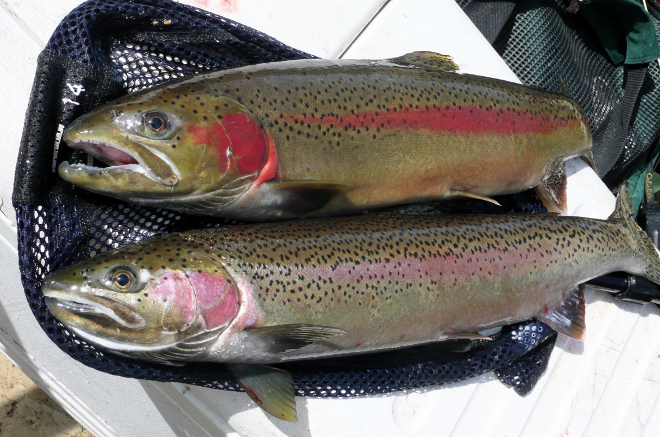
IDFG Public Information Specialist
Big fish, lots of bank access, beautiful weather. Well, two of three ain’t bad, and you might get all three during spring steelhead season. Steelhead make their final push to the headwaters of Idaho’s famous steelhead streams during spring, which concentrates them in the upper tributaries of the Clearwater and Salmon rivers.
Anglers key in on these areas for the opportunity to catch these large, ocean-going fish that are traveling upwards of 900 miles to hatcheries or spawning grounds. Those looking to cure cabin fever can get an early start on their fishing season, as well as a chance to catch big fish.
Now about that weather. As most folks know, spring in Idaho is unpredictable, which can apply to other seasons as well. But spring is unique, especially this year, because we’re looking at a large snowpack in much of Idaho’s mountains. Warm, sunny weather, or rainy weather, can turn rivers into muddy torrents and make steelhead fishing difficult, so watching river flows is critical to the success of spring steelhead fishing.
Anglers can see a gauge of river flows thanks to the U.S. Geological Survey, which has gauging stations throughout Idaho.
By watching the weather and the streamflows, anglers can track in real time what’s happening with the rivers.
Steelhead typically like “Goldilocks” conditions, not too high and not too low and with a little color in the water (think emerald green), but not muddy. Warming water (even just a few degrees) often offers better fishing, and when a river recedes after a big pulse of run off also tends to fish better. Good steelhead anglers, or lucky ones, can catch fish in almost any conditions, but using those guidelines will help you improve you chances of catching steelhead.
Unlike salmon fishing where fishing is often curtailed to ensure enough fish reach hatcheries, steelhead fishing is typically wide open. Idaho easily refills its hatcheries with enough adult steelhead to replenish the egg supply needed to produce the next generation of fish. That means anglers have a long steelhead fishing season and generous bag limits. To see rules for each river system, go here.
With fish congregated in smaller areas, anglers are too, which means there can be crowding. In some cases, that gives steelhead fishing a social atmosphere, but there can also be intense competition for prime fishing spots. See the video below to learn about etiquette for fishing in tight spacing.
But don’t feel like you have to fish shoulder to shoulder with others. The upper Salmon River between Salmon and Stanley, for example, has more than a hundred miles of mostly road-accessible river where you can find places to get away from the crowds.
Here’s more information about steelhead fishing this spring:
Salmon-Challis National Forest Officials reopened the road on March 1. Forest officials reported that although avalanche and debris slide conditions improved with cooling temperatures and melting snow, the public is advised to avoid traveling on the road unless they are prepared for unpredictable road and weather conditions.
“As in previous years, the Salmon River Road will continue to have avalanche and debris slides occurring throughout the spring run-off season,” officials said.
Boat ramps are also blocked by high snowbanks, and there's limited parking along the road due to snow on the shoulders.
For updated information about the road call (208) 756-5100 or visit https://www.fs.usda.gov/scnf.
Hatchery managers want young steelhead released into the South Fork of the Clearwater River to be from parents taken from that river, so it is asking anglers to catch local spawners to fill nearby hatcheries.
Here’s how it works: Anglers catch a fish, and then place the live fish into a perforated section of PVC pipe provided by Fish and Game. Anglers return the pipe to the river and tether it, and then F&G crews retrieve the fish and put it into a tanker truck that will deliver the steelhead to the hatcheries.
Fish and Game will distribute the PVC pipes at popular fishing holes along the South Fork in March, the most popular times for fishing the river. Steelhead donated by anglers are not counted against the angler’s bag limit.
For more information about the program, call (208) 799-5010.